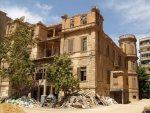In the footsteps of Lawrence of Alexandria


By Justin Tuijl
- 209 reads
Forget the hippie trail: follow Lawrence Durrell to Alexandria on a literary trail
Taking the bus through the dusty yellow landscape of Egypt from Cairo to Alex couldn’t be more, well, Egyptian. You can forget struggling through the desert to arrive for your ice cold Carlsberg like John Mills in Ice Cold in Alex, today you will take a luxury bus with air conditioning, food and Egyptian coffee. From the window the roads are a snapshot of Egyptian life with camels watching you riding in the back of pickup trucks and a vast assortment of private and commercial vehicles.
Dusty and yellow are the words to describe the view, and it is rather a strain on English eyes used to green and pleasant lands. There’s not a stick of vegetation, not a leaf or sign of green. As you approach Alex the landscape is very industrial, the modern gods of worship in a landscape littered with monolithic machinery and crafted excavations on a larger scale than the pyramids.
Soon this spectacle drops away and the unassuming low lying suburbs of Alex come into view. Your luxury bus stops in a very un-luxurious bus station which stretches a great distance around. A few portacabins make up the only buildings.
Your chosen form of transport takes sometime to reach the Grand Corniche; here the wide strip of road, along the deep blue bay of Alexandria, with its permanent throng of honking six lane traffic; the modern music of Alex: car horns and the call to prayer.
Alexandria: one of the most ancient cities in the world, with the least to show for it. This is where two wonders of the world stood: the great library and the great lighthouse. Of the library, nothing remains, and of the lighthouse, well, if you are a diver you can go and find its stones under the bay. In-fact that is where most of Alexandria’s antiquities lay: under the water, relics from the pharaohs in a watery grave.
Most of Alexandra is modern buildings built on top of the ancient city. There are a few exceptions: a throng of ex-British Victorian hotels line the bay, but to the west of the city, the big attraction, Pompey’s Pillar, a Roman ornate column thrusting its lone triumphal finger to the sky.
Of course in Durrell’s day the bay was full of warships as the black clouds of the Second World War gathered. His masterpiece The Alexandria Quartet is a snapshot of the cosmopolitan city during that time. It is a four volume novel of prose poetry following the life and loves of expatriates in the diverse city during a time of great upheaval.
Here you can take a literary pilgrimage to the last cultural relic ready to go under the new Alex. Be warned: you maybe too late. If you navigate your way into the busy back streets, stepping into the traffic to cross roads, the excepted method in Egypt, you will eventually arrive at a ruin waiting to happen: the crumbing Villa Ambron. This is where Durrell wrote. His study was in the top of the tower on the corner of the Villa. Here he composed notes for the Alexandria Quartet and wrote Prospero’s Cell, which features the tower on the cover. From his window he used to see Pompey’s Pillar. Now, tower blocks obscure the view. The current owner of the Villa is not allowed to demolish it, but he has gutted the interior hoping the building will crumble, after which he will build a tower block.
The house of the famous Alexandrian poet Constantine P. Cavafy is preserved for posterity. The Villa Ambron? Soon maybe you can view it by diving in the bay. (2022 update - yes, they did demolish it)
Picture:
The Villa Ambron 2010 – Alexandria – Copyright Justin Tuijl - The picture is by me. They pinched it for their article.
See an article in the Telegraph by Richard Spencer (yes they used my picture)
Further links of interest:
Michael Haag: Lawrence Durrell’s House in Alexandria
A further post
- Log in to post comments


